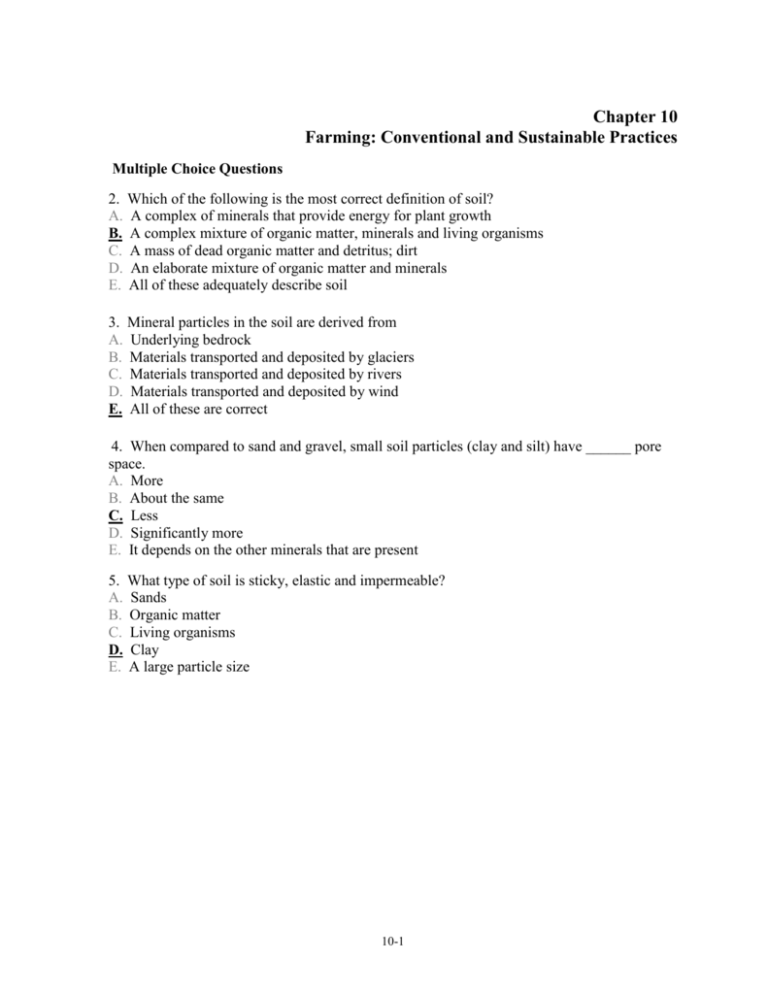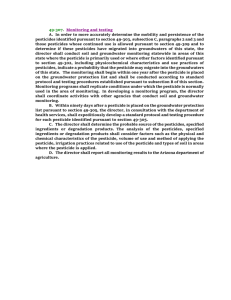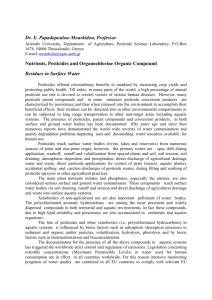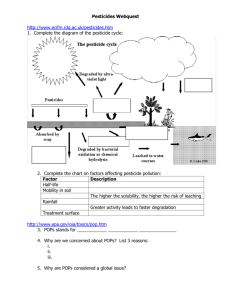Chapter 10 Farming: Conventional and Sustainable - AHS-Esci-L1
advertisement

Chapter 10 Farming: Conventional and Sustainable Practices Multiple Choice Questions 2. Which of the following is the most correct definition of soil? A. A complex of minerals that provide energy for plant growth B. A complex mixture of organic matter, minerals and living organisms C. A mass of dead organic matter and detritus; dirt D. An elaborate mixture of organic matter and minerals E. All of these adequately describe soil 3. Mineral particles in the soil are derived from A. Underlying bedrock B. Materials transported and deposited by glaciers C. Materials transported and deposited by rivers D. Materials transported and deposited by wind E. All of these are correct 4. When compared to sand and gravel, small soil particles (clay and silt) have ______ pore space. A. More B. About the same C. Less D. Significantly more E. It depends on the other minerals that are present 5. What type of soil is sticky, elastic and impermeable? A. Sands B. Organic matter C. Living organisms D. Clay E. A large particle size 10-1 6. Spaces between sand particles give sandy soil A. The ability to hold water B. Low permeability to air C. Good drainage D. The ability to store minerals E. Low permeability to water 7. A "heavy" soil would have a high ____________ content. A. Sand B. Iron C. Silt D. Clay E. Gravel 8. The critical organic component of soil that gives it its structure is termed A. Clay B. Humus C. Parent material D. Heavy soil E. Bedrock 9. Which of the following cannot be found in soil? A. Fungus and algae B. Algae and bacteria C. Insects and bacteria D. Insects and fungus E. All of these are found in soil 10. Topsoil contains predominantly A. Organic material B. Mineral material C. Plant roots D. Insoluble minerals and sand E. Mixed organic material and mineral particles 10-2 11. A. B. C. D. E. Which of the following would have nearly zero topsoil? Virgin prairies Deserts Tropical rainforests Tundra None of these is correct 12. The parent material layer of a soil is composed of weathered A. Humus B. Organic detritus and roots C. Residual aluminum and iron D. Soil E. Rock fragments 15. The stratified horizontal layers of soils are called soil A. Profiles B. Horizons C. Textures D. Types E. Classifications 16. Soil leaching involves A. Rainwater seeping through soil and dissolving nutrients B. The accumulation of organic matter in the uppermost soil layers C. The elimination of pore space in soil D. The microorganisms and their movements through the soil to aerate it E. All of these are correct 17. In developed countries, the most recent increases in agricultural productivity have come from A. B. C. D. E. Irrigation in arid areas Increased fertilization New crop varieties An increase in the land being used for agriculture Irrigation, increased fertilization and new crop varieties 10-3 18. A. B. C. D. E. Which of the following are not forms of chemical deterioration of soil? Salinization Waterlogging Nutrient depletion Pollution Acidification 20. Wind erosion is most likely to cause problems in A. Forested grazing lands on high mountains B. Open, arid regions C. Fertile river bottoms with annual floods D. Agricultural regions in the far north E. Protected, arid regions 21. A. B. C. D. E. An effective way to measure soil erosion in a region is to measure the Amount of dust in the air Sediment load of rivers Amount lost on crop fields Distance the dust travels All of these are effective ways to measure the loss 22. The efficiency of irrigation water use is ______ in most countries. One of the reasons for this is ______. A. High; the abundance of water B. High; the careful use of water because it is so expensive C. High; the technology to distribute the water where it is needed is available D. Low; the lack of availability of technology to distribute the water where it is needed E. Low; evaporative losses from unprotected water channeling 24. A. B. C. D. E. Which is the best cropping method for reducing erosion? Rotating corn, wheat and clover Growing corn continuously Growing wheat continuously Growing clover continuously None of these is more effective in reducing erosion 25. Which of the following uses the least amount of energy in industrialized farming practices? A. Fuel for tractors and other machines B. Production of chemical fertilizer C. Use of pesticides D. Drying the crops E. Transporting the crops to market 10-4 26. A. B. C. D. E. Waterlogging results from Toxic metal accumulation Excessive irrigation Excessive plowing Natural wind erosion processes Natural water erosion processes 27. Salinization is a common agricultural problem in what type of region? A. Arid B. Cold C. Tropical D. Humid E. Windy 28. Legumes are plants whose roots contain bacteria that can fix ___________ and naturally fertilize the plant. A. Nitrogen B. Phosphorus C. Potassium D. Oxygen E. All of these are correct 29. Pest organisms tend to be A. Specialist species B. Generalist species C. Migratory species D. Endemic species E. Consumers 32. DDT accumulation in North American eagles, pelicans and other birds disrupted birds' calcium metabolism, causing A. Infertility B. Thin eggshells C. Severe nerve damage D. Adult deformities E. All of these are correct 33. DDT is A. Equally toxic to mammals and insects B. Soluble only in water C. Cheap to produce and easy to apply D. Highly biodegradable E. All of these are correct 10-5 34. A broad-spectrum biocide is designed to kill A. A wide range of plants B. Microbes that are neither plant nor animal C. A wide range of living organisms D. Specifically multicellular organisms E. Specifically unicellular organisms 35. Alcohol and pickling solutions were probably widely developed because they A. Neutralize toxins in foods B. Preserve food due to their pesticidal properties C. Have more interesting flavors than other solutions for seasoning D. Are effective insecticides in the home E. All of these are good reasons why alcohol and pickling solutions were used 36. Which of the following has been used historically to reduce agricultural pests? A. Arsenic B. Alcohol fermentation C. Spices D. Sulfur E. All of these methods have been used as pest control 37. Which of the following usually has the most intensive use of pesticides? A. A soybean field B. A golf course C. An average U.S. kitchen D. A corn field E. All of these are comparable 38. Which of the following pesticide types is extremely toxic to workers who apply them? A. Chlorinated hydrocarbons B. Carbamates C. Inorganic pesticides D. Fumigants E. Natural organic pesticides 39. Most of the pesticides applied in the United States are used in A. Landscaping for private homes B. Agriculture C. Controlling pests in private homes D. Landscaping for both private homes and businesses E. Controlling pests in businesses (e.g., restaurants) 10-6 40. Why is it useful to classify pesticides by their chemical structure? A. It is easier to keep them organized by type B. Scientists have done this for years and it would be inefficient to change it now C. Similar chemical structures often relate to similar toxicological characteristics D. This is how they are named and looking them up for reference is easier E. This is how they are named and the regulations use these names 42. Inorganic pesticides are generally A. Highly toxic and remain in the soil for a long time B. Highly toxic and break down soon in the environment C. Moderately toxic and remain in the soil for a long time D. Moderately toxic and break down soon in the environment E. Toxic to insects but safe for humans 43. Natural organic pesticides are not A. Extracted from plants B. Toxic to humans C. Safe for all animals D. Stable in their natural form E. All of these are characteristics of natural organic pesticides 10-7 44. In general, microbial agents are A. Wide spectrum agents B. Used in place of chemical pesticides C. Small molecules that gasify easily D. Small molecules that penetrate rapidly into a variety of materials E. Persistent in the soil for a long time 45. Chlorinated hydrocarbons have ____ toxicity for sensitive organisms and remain in the soil for a _______ time. A. High; long B. High; short C. Low; short D. Low; long E. Medium; long 46. DDT is a A. Chlorinated hydrocarbon (organochloride) B. Natural organic pesticide C. Chlorinated inorganic pesticide D. Organophosphate E. Carbamate 50. Which of the following diseases cannot be decreased with insecticides? A. Malaria B. Sleeping sickness C. Bronchitis D. Yellow fever E. West Nile virus 51. In terms of agriculture, pesticides have lead to _____ for consumers. A. Lower monetary costs B. More attractive produce C. Better produce quality D. More availability of produce E. All of these are correct 52. Approximately ______ percent of the pesticides we use never reach the intended target. A. 15 B. 20 C. 75 D. 50 E. 90 10-8 53. Pest resurgence is part of the problem of pesticide resistance and happens when a pest organism A. That was dormant during pesticide application becomes active and produces offspring B. Adapts to the pesticide and produces tolerant offspring C. Adapts to the pesticide and produces even more pesticide-tolerant offspring D. That is tolerant to the pesticide survives and produces tolerant offspring E. Receives a gene for pesticide tolerance through a virus infection 54. Pesticide resistance occurs when a population of pests A. Becomes too numerous for chemicals to control B. Genetically changes (through natural selection) and is no longer affected by the chemicals C. Grows extremely large because of chemical misapplications D. Is not affected by chemicals because the pesticide chemicals do not break down in the environment E. Is completely wiped out by the pesticide chemicals 55. Can an organism be resistant to a chemical that it has never been exposed to? A. Yes, genes for pesticide resistance can be transferred through vectors such as viruses B. Yes, pesticide resistance does not require chemical exposure and eventually all organisms become resistant C. Yes, the pesticide treadmill causes pesticide resistance D. No, there is probably some exposure that we are not aware of E. No, it is not possible for an organism be resistant to a chemical that it has never been exposed to 56. The pesticide treadmill occurs when A. A virus transfers pesticide resistance to a new species B. Constantly decreasing doses of pesticides are needed to control pests C. Nontarget agricultural species are destroyed by insecticides D. Predators of the pest species are killed by broadcast spraying E. Constantly increasing doses of pesticides are needed to control pests 57. Pesticide resistance only occurs in __________ species. A. Weed B. Insect C. Plant pathogen D. Weed and insect E. All of these are correct 10-9 10-10 58. In the graph, which of the populations first began to show pesticide resistance? A. A B. B C. C D. D E. It is impossible to answer the question with the provided data 59. Looking at the graph and given what you know about pesticide resistance, what do you think will probably happen to curve "b" in the future? A. It will level off B. It will continue to increase C. It will decrease D. It will increase a small amount and then level off E. It is impossible to answer the question with the provided data 63. When a new pesticide is developed the best thing to do is to use it A. Sparingly so pests will not develop a resistance B. Widely and liberally, to knock out pests C. Widely and liberally, so pests will not develop a resistance D. Liberally then sparingly to prevent resistance and knock out pests E. Sparingly then liberally to prevent resistance and knock out pests 64. Why are pest predator populations so adversely affected by broad-spectrum pesticides? A. In general, predators are more susceptible to the pesticides B. There is less food for the predators when the pest species is destroyed C. Predators in higher trophic levels are more likely to be wiped out than lower trophic levels D. Broad-spectrum pesticides leave more residues than other pesticides and these kill the predators E. Predator populations are not more likely to be adversely affected 65. When pesticide residues are found in such remote areas as the St. Lawrence estuary, which of the following is probably not responsible? A. Bioaccumulation B. Pesticide persistence C. The grasshopper effect D. Bioaccumulation and pesticide persistence E. All of these could be responsible 10-11 67. Organic pollutants called ________________ are showing up in many different places worldwide, far from their original source. This has led to a widespread movement to ________________. A. Persistent organic pollutants; ban twelve of them in developed countries B. Mobile organic pollutants; ban twelve of them worldwide C. Persistent organic pollutants; reduce the use of twelve of them D. Mobile organic pollutants; reduce the use of twelve of them E. Persistent organic pollutants; make them less persistent 68. Which of the following is a chronic effect of pesticides on humans? A. Cancer B. Fetal deformities C. Immune system problems D. Parkinson's disease E. All of these are correct 69. In developing countries, the farm workers who account for the majority of illness and death from the most toxic agricultural chemicals are usually the workers who A. Apply the pesticide B. Use machines to harvest grains C. Transport the chemicals D. Handpick fruits and vegetables E. Plow the fields because the pesticide residues are in the dust that can be inhaled 70. The scientific and legal proof of pesticide effects on humans is generally A. Obvious and quickly established B. Clear and therefore easy to put into policy C. Impossible to establish D. Difficult to establish E. Easy to establish 71. Behavioral changes as an alternative to current pesticide use would not include A. Switching from monoculture fields to mixed polyculture fields B. Rotating crops C. Flooding fields before planting D. Habitat diversification E. All of these are behavioral changes as alternatives to current pesticide use 10-12 72. Knowledge of the life cycle of an insect population enables biological controls to be used in place of current pesticide use. An example includes the use of Bacillus thuringiensis (Bt) which affects _______ of moths and butterflies. A. All stages B. The larval stage C. The pupa stage D. The eggs E. The larval and pupa stages 73. Which of the following alternative methods is not helpful in reducing your exposure to pesticides? A. Accept slightly blemished fruits and vegetables B. Purchase praying mantises and ladybugs to protect garden plants C. Use only natural chemicals as pesticides D. Wash aphid-infested vegetation with pure water E. Keep wood piles away from the outside of the house 74. With respect to chemical pest controls, integrated pest management (IPM) uses A. None B. The maximum amount as determined by economic thresholds C. Broad-spectrum products D. The minimum amount necessary as a last resort E. The maximum amount as determined by organic standards 75. In order to institute an integrated pest management program, it is necessary to A. Have large amounts of money B. Use large amounts of space C. Have many different kinds of crops D. Burn all fields to eliminate biological elements E. Understand local plants and animals 76. What is the main reason a conversion from conventional agriculture to organic farming occurred in Cuba? A. The demands of consumers B. The collapse of the socialist bloc C. The high rate of deaths from heavy pesticide use D. The change to a main crop of sugarcane E. All of these factors led to the conversion in Cuba 77. What is one method that Cubans use on a large scale to fertilize their soil? A. They compost kitchen scraps B. They use imported synthetic organic fertilizers C. They use synthetic organic fertilizers produced in Cuba D. They import organic fertilizers E. They use humus from earthworm farms 10-13 78. Which of the following things that you can do to reduce pesticide residues in your diet is related to bioaccumulation? A. Peel fruits and vegetables when possible B. Trim the fat from meat, chicken and fish C. Cook foods that you think have been exposed to chemicals D. Ask for organically grown produce at a farmer's market E. All of these are related to bioaccumulation 79. Contour plowing and strip farming are methods designed to A. Prevent weed spreading B. Improve plowing efficiency C. Improve harvesting efficiency D. Prevent water and soil loss E. Make farms more attractive 80. Which of the following is the best way to ensure soil health? A. Maintaining clean, open ground between rows B. Strip farming and leaving residues on fields after harvest C. Clearing fields immediately after harvesting D. Establishing ridges running up and down hills E. All of these are good practices in ensuring soil health 81. Which of these is not a benefit found with reduced tillage farming? A. Water conservation B. Soil preservation C. Increased crop yields D. Soil aeration E. Decreased insects and weeds 82. One of the drawbacks of leaving crop residues on a field after harvest is increased A. Cost due to the high cost of fertilizers B. Pest and disease problems C. Salinization D. Energy use of machinery E. Wind erosion 83. The benefits of leaving crop residues on a field after harvest include A. Protecting soil organisms B. Reducing evaporation C. Breaking the erosive effects of wind and water D. All of these are correct 10-14 84. Another word for cover crops is A. Mulch B. Strip farming C. Green manure D. Shade planting E. All of these are correct 85. Annual row crops such as __________ cause the highest erosion rates because _____________. A. Corn and coffee; they use so many nutrients B. Wheat and coffee; they need so much water C. Tea and beans; plowing in the fall is required for planting of these annual spring crops D. Beans and coffee; trees are usually cut down for the fields E. Corn and beans; soil is left bare for the majority of the year 10-15







